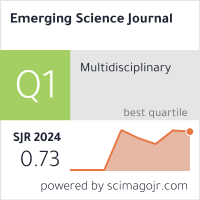Machine Learning and Parameter Optimization for Banking Stability Prediction and Determinants Identification in ASEAN
Downloads
This study leverages machine learning and advanced variable selection techniques to enhance the prediction of the Bank Financial Stability Index (Z-score) in emerging ASEAN markets. Utilizing a comprehensive secondary dataset comprising macroeconomic and bank-specific indicators from 61 commercial banks across Indonesia, Malaysia, the Philippines, Singapore, Thailand, and Vietnam (2010–2023), we systematically evaluate the predictive power of multiple machine learning models. A rigorous cross-validation framework is employed to optimize forecasting accuracy, integrating Linear Regression, Random Forest, K-Neighbors, Decision Tree, Gradient Boosting, AdaBoost, Support Vector Regression, and XGBoost with Lasso, Ridge, and Elastic Net regularization. Empirical results reveal that key drivers of financial stability include equity capital, financial leverage, return on equity, GDP growth, inflation, technological advancements, and systemic shocks like the COVID-19 pandemic. Notably, the Ridge-optimized XGBRegressor model achieves the highest predictive accuracy (~89%), demonstrating the efficacy of hybrid machine learning approaches in financial stability forecasting. These findings offer crucial insights for policymakers and regulators, facilitating data-driven strategies to strengthen banking resilience and mitigate systemic risks in volatile economic environments.
Jel Classifier: C45, C52, C55, G21, G32.
Downloads
[1] Beaver, W. H. (1966). Financial Ratios as Predictors of Failure. Journal of Accounting Research, 4, 71. doi:10.2307/2490171.
[2] Altman, E. I. (1968). Financial Ratios, Discriminant Analysis and the Prediction of Corporate Bankruptcy. The Journal of Finance, 23(4), 589. doi:10.2307/2978933.
[3] Altman, E. I., & Hotchkiss, E. (2011). Corporate Financial Distress and Bankruptcy: Predict and Avoid Bankruptcy, Analyze and Invest in Distressed Debt, Third Edition. In Corporate Financial Distress and Bankruptcy: Predict and Avoid Bankruptcy, Analyze and Invest in Distressed Debt. John Wiley & Sons, New Jersey, United States. doi:10.1002/9781118267806.
[4] Ben Lahouel, B., Taleb, L., Ben Zaied, Y., & Managi, S. (2024). Financial stability, liquidity risk and income diversification: evidence from European banks using the CAMELS–DEA approach. Annals of Operations Research, 334(1–3), 391–422. doi:10.1007/s10479-022-04805-1.
[5] Thabet, H. H., Darwish, S. M., & Ali, G. M. (2024). Measuring the efficiency of banks using high-performance ensemble technique. Neural Computing and Applications, 36(27), 16797–16815. doi:10.1007/s00521-024-09929-y.
[6] Boubaker, S., Ngo, T., Samitas, A., & Tripe, D. (2024). An MCDA composite index of bank stability using CAMELS ratios and shannon entropy. Annals of Operations Research, 1–24. doi:10.1007/s10479-024-06023-3.
[7] Noman, A. H. M., Gee, C. S., & Isa, C. R. (2017). Does competition improve financial stability of the banking sector in ASEAN countries? An empirical analysis. PLoS ONE, 12(5), 176546. doi:10.1371/journal.pone.0176546.
[8] Sun, X., Yuan, P., Yao, F., Qin, Z., Yang, S., & Wang, X. (2024). Financial Fragility in Emerging Markets: Examining the Innovative Applications of Machine Learning Design Methods. Journal of the Knowledge Economy, 1-22. doi:10.1007/s13132-023-01731-w.
[9] Altman, E. I., Haldeman, R. G., & Narayanan, P. (1977). ZETATM analysis A new model to identify bankruptcy risk of corporations. Journal of Banking and Finance, 1(1), 29–54. doi:10.1016/0378-4266(77)90017-6.
[10] Ben Jabeur, S., Stef, N., & Carmona, P. (2023). Bankruptcy Prediction using the XGBoost Algorithm and Variable Importance Feature Engineering. Computational Economics, 61(2), 715–741. doi:10.1007/s10614-021-10227-1.
[11] Beck, T., De Jonghe, O., & Schepens, G. (2013). Bank competition and stability: Cross-country heterogeneity. Journal of Financial Intermediation, 22(2), 218–244. doi:10.1016/j.jfi.2012.07.001.
[12] Ho, T. H., Nguyen, D. T., Luu, T. B., Le, T. D. Q., & Ngo, T. D. (2023). Bank performance during the COVID-19 pandemic: does income diversification help? Journal of Applied Economics, 26(1), 26 1. doi:10.1080/15140326.2023.2222964.
[13] Pham, T. T., Dao, L. K. O., & Nguyen, V. C. (2021). The determinants of bank’s stability: a system GMM panel analysis. Cogent Business and Management, 8(1), 1–18. doi:10.1080/23311975.2021.1963390.
[14] Wu, J., Chen, L., Chen, M., & Jeon, B. N. (2020). Diversification, efficiency and risk of banks: Evidence from emerging economies. Emerging Markets Review, 45(3), 1007–1020. doi:10.1016/j.ememar.2020.100720.
[15] Efron, B., Hastie, T., Johnstone, I., Tibshirani, R., Ishwaran, H., Knight, K., Loubes, J. M., Massart, P., Madigan, D., Ridgeway, G., Rosset, S., Zhu, J. I., Stine, R. A., Turlach, B. A., Weisberg, S., & Johnstone, I. (2004). Least angle regression. Annals of Statistics, 32(2), 407–499. doi:10.1214/009053604000000067.
[16] Friedman, J. H. (2001). Greedy function approximation: A gradient boosting machine. Annals of Statistics, 29(5), 1189–1232. doi:10.1214/aos/1013203451.
[17] Shrivastava, S., Jeyanthi, P. M., & Singh, S. (2020). Failure prediction of Indian Banks using SMOTE, Lasso regression, bagging and boosting. Cogent Economics and Finance, 8(1), 17259–17269. doi:10.1080/23322039.2020.1729569.
[18] Zaghdoudi, T. (2013). Bank failure prediction with logistic regression. International Journal of Economics and Financial Issues, 3(2), 537–543.
[19] Shi, Y., Charles, V., & Zhu, J. (2024). Bank financial sustainability evaluation: Data envelopment analysis with random forest and Shapley additive explanations. European Journal of Operational Research, 321(2), 614–630. doi:10.1016/j.ejor.2024.09.030.
[20] Climent, F., Momparler, A., & Carmona, P. (2019). Anticipating bank distress in the Eurozone: An Extreme Gradient Boosting approach. Journal of Business Research, 101, 885–896. doi:10.1016/j.jbusres.2018.11.015.
[21] Herawati, N., Wijayanti, A., Sutrisno, A., Nusyirwan, & Misgiyati. (2024). The Performance of Ridge Regression, LASSO, and Elastic-Net in Controlling Multicollinearity: A Simulation and Application. Journal of Modern Applied Statistical Methods, 23(2), 1–13. doi:10.56801/Jmasm.V23.i2.4.
[22] Safi, S. K., Alsheryani, M., Alrashdi, M., Suleiman, R., Awwad, D., & Abdalla, Z. N. (2023). Optimizing Linear Regression Models with Lasso and Ridge Regression: A Study on UAE Financial Behavior during COVID-19. Migration Letters, 20(6), 139–153. doi:10.59670/ml.v20i6.3468.
[23] Radchenko, N., Rubtsova, N., Chkan, I., & Yakysheva, I. (2019). Methodical approaches to implementation of financial bank stability. In Modern Development Paths of Agricultural Production: Trends and Innovations, 547–559. doi:10.1007/978-3-030-14918-5_54.
[24] Yin, F., Jiao, X., Zhou, J., Yin, X., Ibeke, E., Iwendi, M. G. P., & Biamba, C. (2022). Fintech application on banking stability using Big Data of an emerging economy. Journal of Cloud Computing, 11(1). doi:10.1186/s13677-022-00320-7.
[25] Hafeez, B., Li, X., Kabir, M. H., & Tripe, D. (2022). Measuring bank risk: Forward-looking z-score. International Review of Financial Analysis, 80, 1020–1039. doi:10.1016/j.irfa.2022.102039.
[26] Arzova, S. B., & Sahin, B. S. (2024). The effect of financial soundness variables on bank performance: a macro-level analysis in MSCI Emerging Market Index countries. Kybernetes, 53(8), 2605–2623. doi:10.1108/K-02-2023-0237.
[27] Berger, A. N., Klapper, L. F., & Turk-Ariss, R. (2009). Bank competition and financial stability. Journal of Financial Services Research, 35(2), 99–118. doi:10.1007/s10693-008-0050-7.
[28] Zou, H., & Hastie, T. (2005). Regularization and variable selection via the elastic net. Journal of the Royal Statistical Society. Series B: Statistical Methodology, 67(2), 301–320. doi:10.1111/j.1467-9868.2005.00503.x.
[29] Tibshirani, R. (1996). Regression Shrinkage and Selection Via the Lasso. Journal of the Royal Statistical Society. Series B: Methodological, 58(1), 267–288. doi:10.1111/j.2517-6161.1996.tb02080.x.
[30] Lumsden, E. (2018). The Future Is Mobil: Financial Inclusion and Technological Innovation in the Emerging World. Stanford Journal of Law, Business & Finance, 23(1), 1-44.
[31] Puli, S., Thota, N., & Subrahmanyam, A. C. V. (2024). Assessing Machine Learning Techniques for Predicting Banking Crises in India. Journal of Risk and Financial Management, 17(4), 141. doi:10.3390/jrfm17040141.
[32] Barboza, F., Kimura, H., & Altman, E. (2017). Machine learning models and bankruptcy prediction. Expert Systems with Applications, 83, 405–417. doi:10.1016/j.eswa.2017.04.006.
[33] Fernández Fernández, J. A. (2020). United States banking stability: An explanation through machine learning. Banks and Bank Systems, 15(4), 137–149. doi:10.21511/bbs.15(4).2020.12.
[34] Alessi, L., & Detken, C. (2018). Identifying excessive credit growth and leverage. Journal of Financial Stability, 35, 215–225. doi:10.1016/j.jfs.2017.06.005.
[35] Tanaka, K., Kinkyo, T., & Hamori, S. (2016). Random forests-based early warning system for bank failures. Economics Letters, 148, 118–121. doi:10.1016/j.econlet.2016.09.024.
[36] Holopainen, M., & Sarlin, P. (2017). Toward robust early-warning models: a horse race, ensembles and model uncertainty. Quantitative Finance, 17(12), 1933–1963. doi:10.1080/14697688.2017.1357972.
[37] Chen, T., & Guestrin, C. (2016). XGBoost: A scalable tree boosting system. Proceedings of the ACM SIGKDD International Conference on Knowledge Discovery and Data Mining, 13-17-August-2016, 785–794. doi:10.1145/2939672.2939785.
[38] Tan, B., Gan, Z., & Wu, Y. (2023). The measurement and early warning of daily financial stability index based on XGBoost and SHAP: Evidence from China. Expert Systems with Applications, 227, 1–17. doi:10.1016/j.eswa.2023.120375.
[39] Pham, X. T. T., & Ho, T. H. (2021). Using boosting algorithms to predict bank failure: An untold story. International Review of Economics and Finance, 76, 40–54. doi:10.1016/j.iref.2021.05.005.
[40] Nguyen, D. T., Le, T. D. Q., & Tran, S. (2024). Competition and bank financial stability: evidence from an emerging economy. Cogent Business and Management, 11(1), 1–16. doi:10.1080/23311975.2024.2365422.
[41] Gebregziabher Gebrehiwot, K., & Makina, D. (2019). Macroeconomic Determinants of Financial Inclusion: Evidence Using Dynamic Panel Data Analysis. Extending Financial Inclusion in Africa, 167–191. doi:10.1016/B978-0-12-814164-9.00008-6.
[42] Nguyen, T. D., & Du, Q. L. T. (2022). The effect of financial inclusion on bank stability: Evidence from ASEAN. Cogent Economics and Finance, 10(1), 1–15. doi:10.1080/23322039.2022.2040126.
[43] Verma, D., & Chakarwarty, Y. (2024). Impact of bank competition on financial stability-a study on Indian banks. Competitiveness Review, 34(2), 277–304. doi:10.1108/CR-07-2022-0102.
[44] Toporowski, J. (2020). The financial instability hypothesis. Credit and Crisis from Marx to Minsky, 74. doi:10.4337/9781788972154.00022.
[45] Stiglitz, J. E., & Weiss, A. (1981). Credit rationing in markets with imperfect information. The American economic review, 71(3), 393-410.
- This work (including HTML and PDF Files) is licensed under a Creative Commons Attribution 4.0 International License.




















